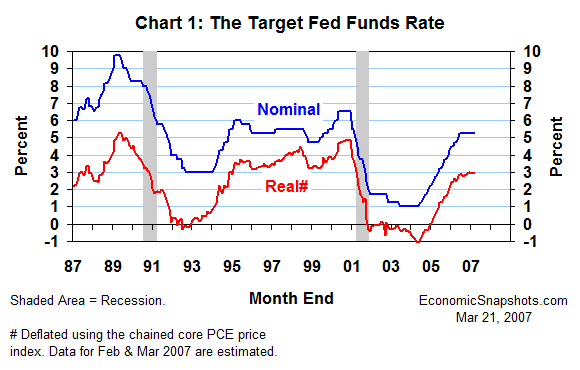
| Back to Index |
March 21, 2007 – The FOMC voted today to leave its Fed funds target unchanged at 5.25% – continuing the “wait and see” monetary policy first adopted in August last year (Chart 1). Before that (from June 2004 through June 2006), the FOMC was in tightening mode, gradually raising its Fed funds target by a total of 425 basis points.

According to the FOMC’s post-meeting policy statement, neither real economic growth nor inflation looks as good as it did when the FOMC last met to discuss U.S. monetary policy on January 30-31.
In the real economy, “Recent indicators have been mixed and the adjustment in the housing sector is ongoing.” That’s a step backward compared to late January, when the FOMC saw “somewhat firmer economic growth” and “some tentative signs of stabilization in the housing market”.
On the inflation front, “Recent readings on core inflation have been somewhat elevated.” In other words, the modest slowing noted in January hasn’t continued in the latest data.
Nevertheless, the FOMC continues to believe in its forecast of a “moderate” trend in U.S. economic growth this year. The FOMC also continues to believe that this relatively subdued trend in real economic growth will be enough to gradually reign in inflation.
Like its predecessors, today’s FOMC statement continued to stress the economy’s inflation risks “In these circumstances, the Committee's predominant policy concern remains the risk that inflation will fail to moderate as expected.” That’s our assurance that the FOMC has no plans to ease U.S. monetary policy in the immediate future.
However, in a major change today, the FOMC tacitly increased its emphasis on downside real economic risks, by eliminating its tightening “bias”.
According to today’s FOMC statement, “Future policy adjustments will depend on the evolution of the outlook for both inflation and economic growth, as implied by incoming information.” (Emphasis added.)
In January, this sentence said, “The extent and timing of any additional firming that may be needed to address these risks will depend on the evolution of the outlook for both inflation and economic growth, as implied by incoming information.” (Emphasis added.)
The replacement of the phrase “additional firming” with the more noncommittal “future policy adjustments” suggests that the FOMC now sees itself as being equally likely to tighten as to ease in coming months. Thus, the FOMC seems to have exchanged its prior tightening “bias” for a neutral stance.
This doesn’t change the bottom line. As long as the FOMC continues to believe in its forecast of moderate economic growth and slowing inflation, the outlook will continue to favor a long stretch of unchanged U.S. monetary policy.
Suzanne Rizzo